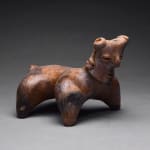Nayarit Dog Effigy Vessel with a Human Face, 300 BCE - 300 CE
Terracotta
height 11.1 cm
height 4 3/8 in
height 4 3/8 in
PF.6297
Further images
This little vessel has been shaped into the form of a dog. It rests, slightly elevated off the ground, on four conical legs. The head rises out of the shoulder...
This little vessel has been shaped into the form of a dog. It rests, slightly elevated off the ground, on four conical legs. The head rises out of the shoulder of the vessel; however, its not the head we would naturally expect. Instead, a human head graces the canine body of this vessel. The facial features are clearly depicted, with eyes and mouth suggested by incised horizontal lines. The ears are also present, with decorative earrings. A large hole on the top of the head would have served as the spout. A little nub of a tail protrudes from the rear. The entire surface of the work was once covered with resist painted patterns, remnants of which are still visible, especially on the front shoulders and back legs. These patterns enhance the beauty of the work and may actually imitate the skin pattern of the hairless dogs after which this work was based. What is the link between the human head and the canine body? Might this offering vessel represent a shaman in the midst of transmogrification? In ancient Mexico, dogs served a variety of roles. They were domesticated companions who served their masters in life. However, they were also one of the staple foods of the Western Mexican diet. Discovered inside a tomb, it is almost certain that this particular dog effigy was not meant to serve as nourishment for the afterlife. Instead, it is possible that this shaman companion would have greeted the deceased and guided him or her through the shadowy perils of the afterlife.





